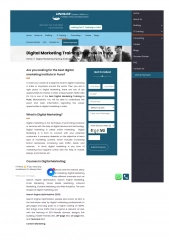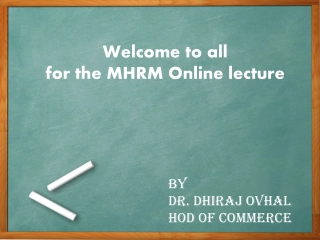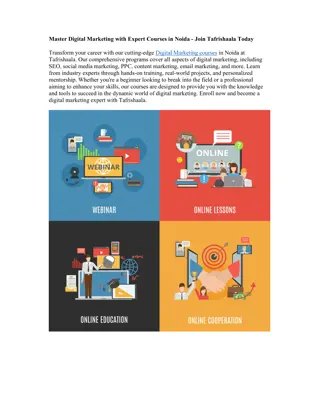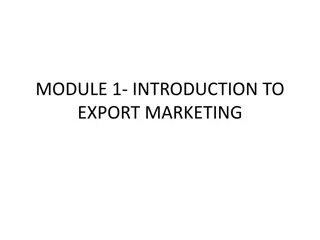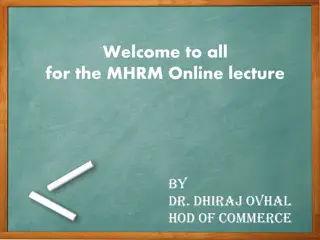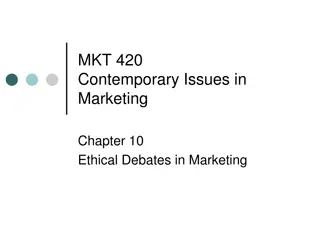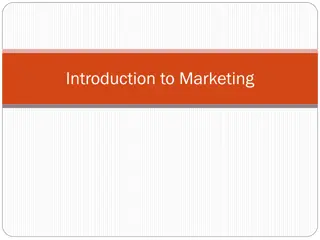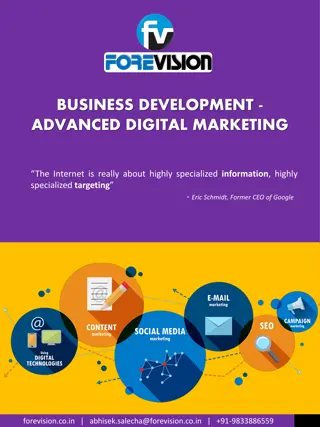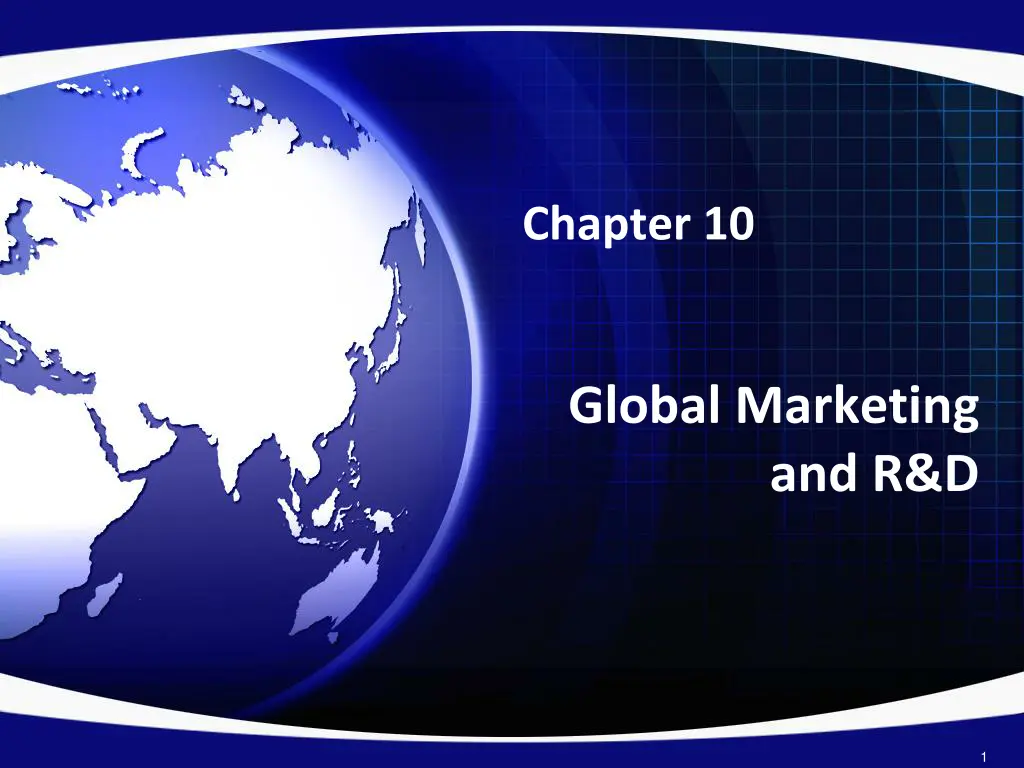
Understanding Global Marketing Strategies and Market Segmentation
Explore the essential components of global marketing, including the marketing mix, market segmentation, product attributes, distribution strategies, and differences between countries. Dive into the case of Buick in China and learn about establishing brand image and distribution strategies in international markets.
Download Presentation

Please find below an Image/Link to download the presentation.
The content on the website is provided AS IS for your information and personal use only. It may not be sold, licensed, or shared on other websites without obtaining consent from the author. If you encounter any issues during the download, it is possible that the publisher has removed the file from their server.
You are allowed to download the files provided on this website for personal or commercial use, subject to the condition that they are used lawfully. All files are the property of their respective owners.
The content on the website is provided AS IS for your information and personal use only. It may not be sold, licensed, or shared on other websites without obtaining consent from the author.
E N D
Presentation Transcript
Chapter 10 Global Marketing and R&D 1
Marketing Mix The marketing mix is comprised of: Product Attributes Distribution Strategy Communication Strategy Pricing Strategy 2
Market Segmentation Market segmentation involves identifying distinct groups of consumers whose purchasing behavior differs from others in important ways Markets can be segmented by: Geography Demography Socio-cultural Factors Psychological Factors 3
Product Attributes A product is like a bundle of attributes Products sell well when their attributes match consumer needs If consumer needs were the same everywhere, a firm could sell the same product worldwide But, consumer needs vary from country to country depending on culture, level of economic development and other factors 4
Buick in China Questions What is the image of Buick in the US? What would be the likely attributes to market Buick in China? 5
Buick in China Questions What is the image of Buick in China? What sells? How did GM establish the Buick brand image and position in China? 6
Distribution Strategy A firm s distribution strategy is a critical element of the marketing mix Product distribution depends on the firm s market entry strategy Firms that manufacturer the product locally can sell directly to the consumer, to the retailer, or to the wholesaler Firms that manufacture outside the country have the same options plus the option of selling to an import agent 7
Differences Between Countries There are four main differences in distribution systems: 1. Retail Concentration = Number of Retailers 2. Channel Length = Number of Intermediaries 3. Channel Exclusivity = Difficulty to access 4. Channel Quality = Expertise of members 8
Choosing A Distribution Strategy The optimal strategy depends on the relative costs and benefits of each alternative Each intermediary in a channel adds its own markup to the products, there is generally a critical link between channel length and the firm's profit margin When price is important, a shorter channel is better A long channel can be beneficial because it economizes on selling costs when the retail sector is very fragmented, and can offer access to exclusive channels 9
Communication Strategy Communicating product attributes to prospective customers is a critical element in the marketing mix 10
Barriers to International Communication The effectiveness of a firm's international communication can be challenged by 1. Cultural barriers 2. Source and country of origin effects 3. Noise levels 11
Barriers To International Communication 1. Cultural Barriers it can be difficult to communicate messages across cultures A message that means one thing in one country may mean something quite different in another. To overcome cultural barriers, firms need to develop Cross-cultural literacy Use local input when developing marketing messages 12
Barriers to International Communication 2. Source and Country of Origin Effects Source effects occur when the receiver of the message evaluates the message on the basis of status or image of the sender Firms can counter negative source effects by deemphasizing their foreign origins 13
Barriers to International Communication 3. Noise Levels Noise refers to the amount of other messages competing for a potential consumer s attention In highly developed countries, noise is very high In developing countries, noise levels tend to be lower 14
Push versus Pull Strategies Firms have to choose between two types of communication strategies: A Push Strategy Emphasizes Personnel Selling A Pull Strategy Emphasizes Mass Media Advertising The choice between the strategies depends upon: 1. Product type and consumer sophistication 2. Channel length 3. Media availability 15
Push versus Pull Strategies 1. Product Type and Consumer Sophistication Firms in consumer goods industries that are trying to sell to a large market segment usually use a pull strategy Firms that sell industrial products typically prefer a push strategy 2. Channel Length A pull strategy can work better with longer distribution channels 16
Push versus Pull Strategies 3. Media Availability A pull strategy relies on access to advertising media When media is not easily available, a push strategy may be more attractive 17
Push versus Pull Strategies In general, a push strategy is better: For industrial products and/or complex new products When distribution channels are short When few print or electronic media are available A pull strategy is better: For consumer goods products When distribution channels are long When sufficient print and electronic media are available to carry the marketing message 18
Global Advertising Standardizing advertising worldwide has both pros and cons Standardized advertising makes sense when: It has significant economic advantages Creative talent is scarce and one large effort to develop a campaign will be more successful than numerous smaller efforts Brand names are global 19
Global Advertising Standardized advertising does not make sense when: Significant Cultural differences among nations Country differences in advertising regulations block the implementation of standardized advertising Some firms use tactics to capture the benefits of global standardization while responding to individual cultural and legal environments Some features of a campaign are standardized while others are customized to local markets 20
Pricing Strategy International pricing is an important element in the marketing mix There are three issues to consider: The case for price discrimination Strategic pricing Regulations that affect pricing decisions 21
Price Discrimination Price discrimination occurs when firms charge consumers in different countries different prices for the same product Firms using price discrimination hope it will boost profits For price discrimination to work: The firm must be able to keep national markets separate Different price elasticity's of demand must exist in different countries 22
Price Discrimination Elastic and Inelastic Demand Curves 23
Strategic Pricing Strategic pricing has three aspects: 1. Predatory Pricing 2. Multi-point Pricing 3. Experience Curve Pricing 24
Strategic Pricing 1. Predatory Pricing Predatory pricing involves using the profit gained in one market to support aggressive pricing designed to drive competitors out in another market After the competitors have left, the firm will raise prices 25
Strategic Pricing 2. Multi-point Pricing Multi-point pricingrefers to the fact that a firm s pricing strategy in one market may have an impact on a rival s pricing strategy in another market Aggressive pricing in one market may elicit a competitive response from a rival in another critical market 26
Strategic Pricing 3. Experience Curve Pricing Firms that are further along the experience curve have a cost advantage relative to firms further up the curve Firms pursuing an experience curve pricing strategy price low worldwide in an attempt to build global sales volume as rapidly as possible, even if this means taking large losses initially 27
Regulatory Influences On Prices The use of either price discrimination or strategic pricing may be limited by national or international regulations A firm s ability to set its own prices may be limited by: 1. Antidumping Regulations 2. Competition Policy 28
Configuring The Marketing Mix Standardization versus customization is not an all or nothing concept Most firms standardize some things and customize others Firms should consider the costs and benefits of standardizing and customizing each element of the marketing mix 29
New Product Development Competition is as much about technological innovation as anything else Pace of technological change is faster than ever Product life cycles are often very short Companies need to make product innovation a priority Requires close links between R&D, marketing, and manufacturing 30
Location Of R&D New product ideas come from the interactions of scientific research, demand conditions, and competitive conditions The rate of new product development is greater in countries where: Large Investments Basic/Applied R&D Demand Is Strong Consumers Are Affluent Competition Is Intense 31
Integrating R&D, Marketing, and Production New product development has a high failure rate To reduce the chance of failure, new product development efforts should involve close coordination between R&D, marketing, and production This integration will ensure that: Customer needs drive product development New products are designed for ease of manufacture Development costs are kept in check Time to market is minimized 32
GM Global Research Network Questions What is GM s previous and current R&D strategies? What is GM s general opinion about where the best technical capability is located? Is this good news or bad news for people in the automobile technical field? 33
Cross-Functional Teams Cross-functional integration is facilitated by cross- functional product development teams Effective cross functional teams should: Be Led By a Project Manager With Status In The Organization Include Members From All The Critical Functional Areas Have Members Located Together Establish Clear Goals Develop An Effective Conflict Resolution Process 34
Building Global R&D Capabilities To adequately commercialize new technologies, firms need to integrate R&D and marketing Commercialization of new technologies may require firms to develop different versions for different countries This may require R&D centers in North America, Asia, and Europe that are closely linked by formal and informal integrating mechanisms with marketing operations in each country in their regions, and with the various manufacturing facilities 35



